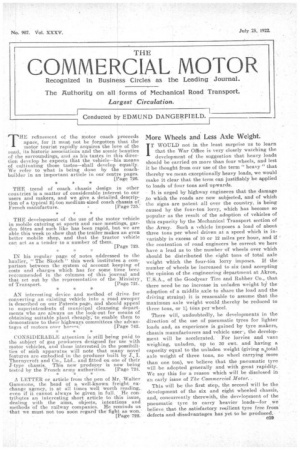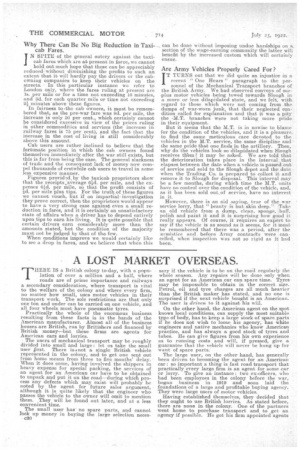More Wheels and Less Axle Weight.
Page 1

Page 2

If you've noticed an error in this article please click here to report it so we can fix it.
IT WOULD not in the least surprise us to learn that the War Office is very closely watching the development of the suggestion that heavy loads should be carried on more than four wheels, and lest it be thought from our use of the term "heavy " that thereby we mean exceptionally heavy loads, we would make it clear that the term can justifiably be applied to loads of four tons and upwards.
, It is urged by highway engineers that the damage ,to which the roads are now subjected, and of which the signs are patent all over the country, is being caused by the four-ton lorry, which has become so popular as the result of the adoption of vehicles of this capacity by the Mechanical Transport section of the Army. Such a vehicle imposes a load of about three tons per wheel driven at a speed which is invariably in excess of 10 or 12 miles per hour, and if . the contention of road engineers be correct we here have a lead as to the number of wheels over which should be distributed the eight tons of total axle weight which the four-tan lorry imposes. If the number of wheels be increased to six (and accepting the opinion of the engineering department at Akron, U.S.A., of the Goodyear Tire and Rubber Co., that there need be no increase in unladen weight 1n3 the adoption of a middle axle to share the load and the driving strains) it is reasonable to assume that the maximum axle weight would thereby be reduced to three tons, or V-, tons per wheel.
There will, undoubtedly, be developments in the direction of the use of pneumatic tyres for lighter loads and, as experience is gained by tyre makers, chassis manufacturers and vehicle user-, the development will be accelerated. For lorries and vans weighing, unladen, up to 30 cwt. and having a capacity equal to the unladen weight (giving %total axle weight of three tons, no wheel carrying more than one ton), we believe that the pneumatic tyre will be adopted generally and with great rapidity. We say this for a reason which will be disclosed in an early issue of The Commercial Motor. .
This will be the first step, the second will be the development of the six and eight wheeled chassis, and, concurrently therewith, the development of the pneumatic tyre to carry heavier loads—for . we believe that the satisfactory resilient tyre free from defects and disadvantages has yet to be produced.
Why There Can Be No Big Reduction in Taxicab Fares.
/ N SPITE of the general outcry against the taxi cab fares whith are at present in force, we cannot holdout much hope that these can be appreciably reduced. without diminishing the profits to such an extent that it will hardly pay the drivers or the cabowning companies to keep their vehicles on the streets. In this particular instance we refer to London only, where the fares ruling at present are ls. per mile or for a time not exceeding 10 minutes, and 3d. for each quarter mile or time not exceeding 14 minutes 'above these figures. In fairness to,the cab owners, it must be remembered that, as the pre-war fare was 8d. per mile, the increase is only 50 per cent., which certainly cannot be considered excessive in view of the prices ruling in other commodities and services (the increase in railway fares is 75 per cent), and the fact that the increase in the cost of living is still considerably above this amount.
Cab users are rather inclined to believe that the fortunate position in which the cab owners found themselves immediately after the war still exists, but this is far from being the case. The general slackness of trade and the consequent lack of money now compel thousands of erstwhile cab users to travel in some less expensive manner.
Figures providsd, by the taxicab proprietors show that the receipts.average 611c1. per mile, and the expenses 6id. per mile, so that the profit consists of id. per mile plus tips. For the truth,of these figures we cannot vouch, but if on impartialinvestigation they prove correct, then the proprietors would appear to have a very strong case against even a small reduction in fares, and it is certainly an unsatisfactory state of affairs when a driver has to depend entirely upon tips to earn his living. It is quite possible that certain drivers earn considerably more than the amounts stated, but the condition of the majority must not be judged by that of the few.
When conditions improve we would certainly like to see a drop in fares, and we believe that when this -can be done without imposing undue hardships on a, section of the wage-earning community the latter will benefit by the increased custom which will certainly ensue.
AreArmy Vehicles Properly Cared For ?
IT TLTRNS out that we did quite an injustice in a recent " One Hears" paragraph to the personnel of the Mechanical Transport branches: of the British Army. We had observed convoys of surplus motor vehicles being towed towards Slough in a more or less dilapidated state, and we felt, with regard to those which were not coming from the dumps of war-worn junk, that their neglected condition called for explanation and that it was a pity the .M.T. branches were not taking more pride in their equipment.
But it seems that the M.T. is in nowise to blame for the condition of the vehicles, and it is a pleasure to find the same meticulous care devoted to the vehicles in the M.P. service, the same dieipline and the same pride that one finds in the artillery. Then, why do the vehicles look so dilapidated when Slough receives th-e-m I it may be asked. We are told that the deterioration takes place in the interval that elapses between the date when a vehicle is passed out of service and ,sold to the Slough depot and the date when the Trading Co. is prepared to collect it and remove it to Slough for disposal. This interval may be a few months, during which time the M.T. units have no control over the condition of the vehicle, and, as it has been sold out,of service, have no interest in it.
However, there is an oid .saying, true of the war service lorry, that "beauty is but skin deep." Take an old vehicle from a dump, clean, sponge, buff. polish and paint, it and it is surprising how good it really appears. Of course, it requires an expert to say if the vehicle is as sound as it seems, for it must be remembered that there was a period, after the armistice and before Army contraclts. were cancelled, when inspection was not so rigid as it had been.






























